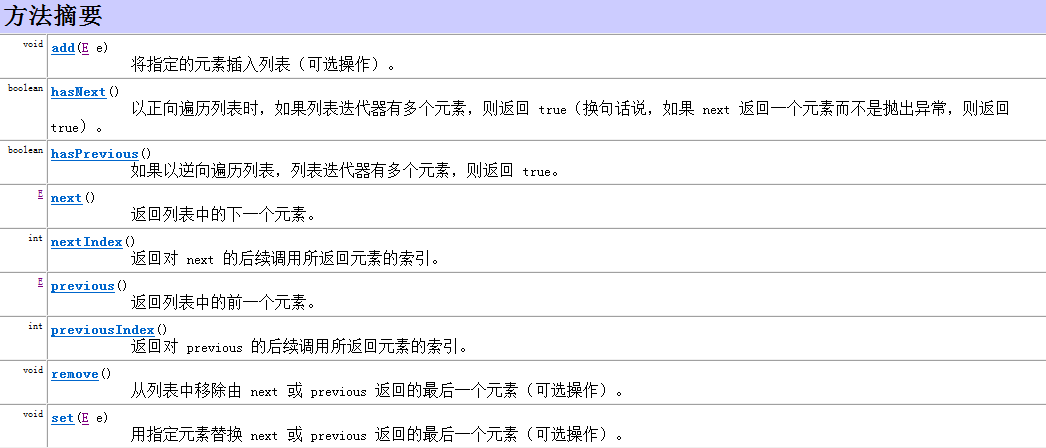一、迭代器概述
1、什么是迭代器?
在Java中,有很多的数据容器,对于这些的操作有很多的共性。Java采用了迭代器来为各种容器提供了公共的操作接口。这样使得对容器的遍历操作与其具体的底层实现相隔离,达到解耦的效果。
在Iterator接口中定义了三个方法:

2、迭代器使用

public static voidmain(String[] args)
{
List list=new ArrayList<>();
list.add("abc");
list.add("edf");
list.add("ghi");
for(Iterator it=list.iterator();it.hasNext();)
{
System.out.println(it.next());
}
}

执行结果:

二、ArrayList的Iterator实现

private class Itr implements Iterator{
int cursor; //index of next element to return
int lastRet = -1; //index of last element returned; -1 if no such
int expectedModCount =modCount;
...}

在ArrayList内部定义了一个内部类Itr,该类实现了Iterator接口。
在Itr中,有三个变量分别是
cursor:表示下一个元素的索引位置
lastRet:表示上一个元素的索引位置
expectModCount:预期被修改的次数
下面看一下Itr类实现了Iterator接口的三个方法:
public booleanhasNext()
{
return cursor != size;//当cursor不等于size时,表示仍有索引元素
}

public E next() //返回下一个元素
{
checkForComodification();
int i =cursor;
if (i >=size)
throw newNoSuchElementException();
Object[] elementData = ArrayList.this.elementData;
if (i >=elementData.length)
throw newConcurrentModificationException();
cursor = i + 1;
return (E) elementData[lastRet =i];
}

在next()方法中有一个checkForComodification()方法,其实现为:
final voidcheckForComodification()
{
if (modCount !=expectedModCount)
throw newConcurrentModificationException();
}
可以看到,该函数是用来判断集合的修改次数是否合法。
在集合内部维护一个字段modCount用于记录集合被修改的次数,每当集合内部结构发生变化(add,remove,set)时,modCount+1。
在迭代器内部也维护一个字段expectedModCount,同样记录当前集合修改的次数,初始化为集合的modCount值。当我们在调用Iterator进行遍历操作时,如果有其他线程修改list会出现modCount!=expectedModCount的情况,就会报并发修改异常java.util.ConcurrentModificationException。下面为示例代码:

public static voidmain(String[] args)
{
ArrayList aList=new ArrayList();
aList.add("bbc");
aList.add("abc");
aList.add("ysc");
aList.add("saa");
System.out.println("移除前:"+aList);
Iterator it=aList.iterator();
while(it.hasNext())
{
if("abc".equals(it.next()))
{
aList.remove("abc");
}
}
System.out.println("移除后:"+aList);
}


上面的代码中,如果我们只使用迭代器来进行删除,则不会出现并发修改异常错误。

public static voidmain(String[] args)
{
ArrayList aList=new ArrayList();
aList.add("bbc");
aList.add("abc");
aList.add("ysc");
aList.add("saa");
System.out.println("移除前:"+aList);
Iterator it=aList.iterator();
while(it.hasNext())
{
if("abc".equals(it.next()))
{
it.remove();
}
}
System.out.println("移除后:"+aList);
}



public voidremove()
{
if (lastRet < 0)
throw newIllegalStateException();
checkForComodification();
try{
ArrayList.this.remove(lastRet);
cursor =lastRet;
lastRet = -1;
expectedModCount =modCount;
} catch(IndexOutOfBoundsException ex) {
throw newConcurrentModificationException();
}
}

在执行remove操作时,同样先执行checkForComodification(),然后会执行ArrayList的remove()方法,该方法会将modCount值加1,这里我们将expectedModCount=modCount,使之保持统一。
三、ListIterator
上面可以看到,Iterator只提供了删除元素的方法remove,如果我们想要在遍历的时候添加元素怎么办?
ListIterator接口继承了Iterator接口,它允许程序员按照任一方向遍历列表,迭代期间修改列表,并获得迭代器在列表中的当前位置。
ListIterator接口定义了下面几个方法:

下面使用ListIterator来对list进行边遍历边添加元素操作:

public static voidmain(String[] args)
{
ArrayList aList = new ArrayList();
aList.add("bbc");
aList.add("abc");
aList.add("ysc");
aList.add("saa");
System.out.println("移除前:" +aList);
ListIterator listIt =aList.listIterator();
while(listIt.hasNext())
{
if ("abc".equals(listIt.next()))
{
listIt.add("haha");
}
}
System.out.println("移除后:" +aList);
}


最后
以上就是开放红酒最近收集整理的关于java集合迭代器_JAVA基础——集合Iterator迭代器的实现的全部内容,更多相关java集合迭代器_JAVA基础——集合Iterator迭代器内容请搜索靠谱客的其他文章。








发表评论 取消回复